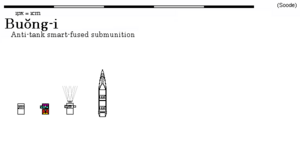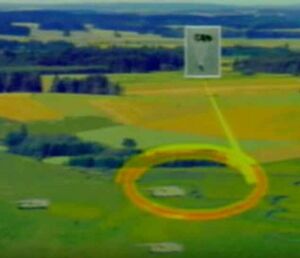Buŏng-i
Buŏng-i (Menghean: 부엉이, "Owl") is the conventional name given to a type of smart-fused anti-tank submunition developed in Menghe. It consists of a cylindrical unit containing a parachute, a shaped charge, and infrared and millimeter-wave radar sensors, and is designed to fire an explosively formed penetrator downward when a tank or other vehicle passes within its field of view. It is a top-attack weapon, and one designed to fire remotely from a height of several dozens of meters, rather than on direct contact.
The Buŏng-i is not meant to be deployed as an independent weapon system, but is instead designed to be dispensed from artillery shells, artillery rockets, aircraft bombs, and certain cruise missiles. This makes it a form of submunition or cluster munition, in that each delivery method usually releases more than one Buŏng-i device.
Design
The Buŏng-i submunition is enclosed within a stackable metal cylinder small enough in diameter to fit within a thin-walled 152mm artillery shell or 150mm artillery rocket. In order from top to bottom, this contains a drag chute, a parachute, a fold-out infrared camera, a targeting-processing unit, an explosive shaped charge, and a millimeter-wave radar antenna. This makes it a fully self-enclosed system with fire-and-forget capability: once the cargo projectile is released, there is no need for the operator to provide further input. It also makes it easy to integrate with existing cargo munitions and launch platforms.
To identify targets, the Buŏng-i submunition uses a combination of three detection measures: an infrared camera, an active millimeter-wave radar, and a passive millimeter-wave radiometer. This approach gives an added level of redundancy, improving the likelihood of correct functioning in inclement weather, such as southern Hemithea's annual monsoon season, and reducing the effectiveness of enemy countermeasures. It can identify both moving and stationary vehicle targets, and can distinguish a hot target from a cool background and a cool target from a hot background.
Because the Buŏng-i can detonate from an altitude of as much as one hundred meters and an angle of as steep as 80 degrees from horizontal, it is also resistant to all known hardkill active protection systems for enemy tanks. The explosively formed projectile also generates greater penetration than feasible levels of roof armor can protect against.
Strictly speaking, Buŏng-i is not a guided munition, but a smart-fused munition: it rotates at a constant rate with non-steering fins, and detonates automatically once a target comes into view. It possesses neither flexible control surfaces nor its own means of propulsion.
Operation
The operational use of the Buŏng-i device is carried out in four steps. First, a projectile containing Buŏng-i submunitions is launched toward the target area. A few carrier projectiles, such as the YSH-54 cruise missile, are guided, but most are unguided, and rely on the projectile's own smart-fused system to ensure impact on the target.
In flight, the projectile expels or dispenses its Buŏng-i submunitions at a pre-set altitude. In 152mm artillery shells, this is done by means of a small explosive charge in the rocket's nose, which pushes the projectiles out the rear after the rear of the shell separates. Artillery rockets and cluster bombs may combine this with smaller charges that break open the projectile's walls, allowing the munitions to disperse further.
In the third stage, the Buŏng-i submunitions decelerate by means of a drag chute, then deploy a separate parachutes, at which point they descend slowly over the battlefield. The parachute mount is slightly off-center, causing the device to hang at an angle, and fold-out fins on the sides cause it to spin at a rate of about one rotation per second as it descends. During this phase, the infrared camera swings out from the side of the electronics housing and the millimeter-wave radar comes online. As the submunition spins and descends, the zone viewed by these sensors spirals inward, ensuring that they will eventually pass over any target within the initial widest ring.
Once the sensors detect an object matching the radar and infrared signatures of an armored vehicle, the warhead immediately detonates, forming an explosively formed penetrator. This projectile then shoots down along the same line-of-sight that identified the tank, striking the target's relatively thinly armored roof. This fourth step takes place in a fraction of a second, and works against both moving and stationary targets.
If the projectile fails to detonate in descent, which will happen if its initial search circle does not contain a target, it will automatically detonate when its millimeter-wave radar determines it is five meters above the ground. Should this system fail as well, it self-destructs two minutes after the initial arming sequence, which provides ample time to descend from regular release altitudes. These measures reduce the threat of unexploded ordnance, allowing ground troops to safely advance over areas where Buŏng-i submunitions were employed.
Specifications
- Weight: 12 kilograms
- Diameter: 146 mm
- Length: 220 mm
- Penetration: over 200 mm
- Kill probability: ~50% (depending on density of targets)
- Self-destruct option: yes
- Self-destruct time: 2 minutes
PT-152 Dalgyal
The PT-152 Dalgyal (달걀, "egg"), formally designated PT-152JSDCh (Potan-152 Jibsokdan, Daejŏncha, "Artillery shell, 152mm, Submunition, Anti-tank") is a 152mm artillery shell designed to carry two Buŏng-i submunitions, stacked on top of each other with the charges facing the nose. As the shell approaches the target, a small charge in the nose detonates and the rear stub separates, allowing the two submunitions to fall out the rear. A base-bleed unit in the rear of the shell allows a range of 34 kilometers when fired from the JJP-152/48 and 28 kilometers when fired from the JJP-152/27, with which it is reverse-compatible.
Specifications (fully loaded 152mm shell with fuse attached)
- Weight: 52 kg
- Length: 95 cm
- Caliber: 152 mm
- Submunitions: 2
- Maximum range: 28-34 km, depending on gun
An export variant, designated Dalgyal-155, uses a 155mm shell compatible with foreign artillery systems in that caliber. It is not used by the Menghean armed forces but has been marketed for export.


